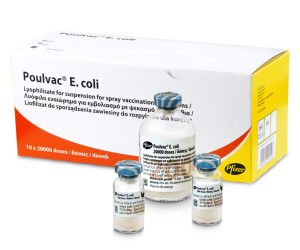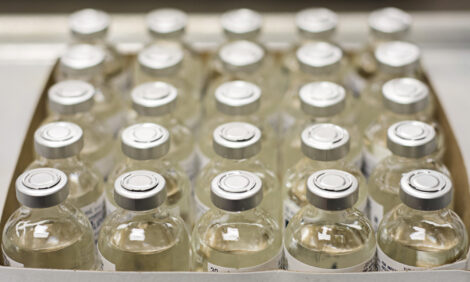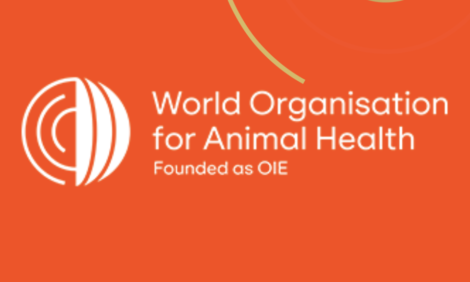



New Vaccine to Protect against Costly Poultry Disease
UK - An innovation in protecting chickens against E.coli bacteria has been achieved with the launch of the first modified live vaccine by Pfizer Animal Health.The Poulvac® E.coli vaccine, which can be used from one day of age, is set to bring major benefits in safeguarding the health of broilers, pullets for egg laying and breeding stock.
E.coli is a costly, widespread problem for the UK poultry industry. It is one of the most significant bacterial pathogens found in chicks during the first week, leading to problems throughout the life of a flock including inferior performance, lack of uniformity and increased mortality.
The vaccine was developed from research beginning in the 1990s at the Government’s veterinary laboratories at Weybridge (now AHVLA) in the UK, employing genome technology to produce an avirulent strain of E.coli that induces protective immunity to the pathogenic strains of the bacteria.
The vaccine is completely non-pathogenic, and does not persist in the bird or the environment for any significant period of time. A gene deletion in its development restricts in vivo replication and leaves behind activated macrophages ready to respond to pathogenic E.coli strains.
“Poulvac E.coli provides broad cross protection against the key serotypes of E.coli infecting chickens,” says Dr Stuart Andrews, poultry technical manager of Pfizer in the UK and Ireland. “It is the only modified live, nonreactive vaccine proven to meet the European regulatory requirements for efficacy and safety.
“Trials have confirmed that Poulvac E.coli does not persist in the bird and proves to be self-limiting. The vaccine can survive in the environment for only a short time, and spread to in-contact birds is also limited.”

The vaccine is administered as a coarse spray with onset of immunity 14 days afterwards and duration of immunity for up to 12 weeks. It can be used from day-old up to six weeks before the onset of lay, and has a nil-day withdrawal period.
Field trials have demonstrated its success in protecting against many different heterologous serotypes on US broiler farms with a history of E.coli problems, showing that identifying a strain’s serotype is not critical to its effectiveness.
Field experience in Morocco was obtained from 112,000 broilers on 15 farms vaccinated with Poulvac E. coli in the hatchery or on the first day on the farm, with another 112,000 birds kept on the same sites as unvaccinated controls.
The vaccinated birds performed better in all parameters investigated. Mortality was 7.7 per cent against 8.8 for the control birds, and incidence of colibacillosis 1.7 per cent against 3.5. Daily weight gain was up from 59 to 61.3 grams, while feed conversion improved from 2.20 to 2.16.
Significantly, too, the vaccinated flocks needed less antibiotic treatment – 0.54 treatment days compared with 1.97 for the controls.
“The commercial experience in Morocco showed clearly the reduction in lesions attributable to E.coli for vaccinated broilers when compared with unvaccinated controls, along with improved performance and health” says Dr Andrews. “It also proved the safety of the vaccine in line with European regulatory requirements with no demonstrable difference in either mortality or performance of the birds during the first two weeks of life.”
In another study in the USA, the vaccine was given to commercial layers at one day of age and again at 12 weeks* with an E.coli challenge at 23 weeks. This showed a 13 per cent reduction in mortality compared with the unvaccinated control birds.
In a flock of 75,000 layers such a lowering of mortality could help protect 3000 hens from mortality, resulting in some 900,000 extra eggs.
In the USA where Poulvac E coli has been available for six years field experience has shown the considerable benefits. In the Midwest where average layer mortality at 50 weeks of age was 2.31 per cent, this was reduced to 1.51 per cent with three doses of the vaccine*. In Eastern US flock mortality compared with five previous flocks was reduced from over three per cent to one per cent.
A field trial in the USA with more than 300,000 broiler breeders vaccination before lay reduced mortality from 2.8 to 1.9 per cent — with only two out of 28 flocks needing antibiotic treatment compared with 13 of the 28 unvaccinated flocks.
On a broiler field trial in Georgia over four million birds were vaccinated with Poulvac E. coli at hatch. The vaccinated birds had a better feed conversion (1.79 against 1.84 for the controls) and with condemnations at the processing plant down from 1.22 to 0.73 per cent the result was a lower production cost of 0.51¢ per lb.
In another broiler trial covering more than two million birds in Arkansas, livability was improved from 95.20 to 95.77 per cent and feed conversion improved from 1.95 to 1.90, gaining 0.45¢ per lb.
* It is important to note that in these studies carried out in the USA more than one dose of the vaccine was often administered. A single vaccination is licensed in the Summary of Product Characteristics however, where clinical disease requires and at the discretion of a veterinary surgeon, the vaccination schedule may be re-started as there is no contra-indication on the SPC.
Impact of E.coli disease
The majority of commercially produced poultry are known to have some E.coli with some strains inherently more pathogenic than others, and when mortality occurs the bacteria is often implicated. Most strains are non-pathogenic and reside within the intestinal tract as commensals, known as avian faecal E.coli.
Andrew Walker, poultry specialist at Slate Hall Veterinary Practice, reports that E.coli is the most common bacteria isolated from post mortem submissions through their laboratory at Willingham, Cambridge.
Those strains causing disease, known as avian pathogenic E.coli (APEC), have developed adaptations enabling them to live outside the intestinal tract, leading to both localised and systemic manifestations of the disease. Most of these strains are pathogenic for poultry only and are responsible for the most common infectious bacterial disease of farmed poultry.
Avian pathogenic E.coli act principally as bacterial ‘opportunists’ that affect both broiler and layer parent flocks and commercial broilers often following immunosuppressive diseases such as infectious bursal disease, chicken anaemia and Marek’s disease and primary upper respiratory disease such as infectious bronchitis, infectious laryngotracheitis or mycoplasmosis.
The most common conditions include septicaemia, peritonitis and salpingitis in broiler breeders and layers; airsacculitis and septicaemia complex in commercial broilers; cellulitis or infectious process resulting in lesions that downgrade broilers at the processing plant, and swollen head syndrome in broilers and occasionally breeders.
Further ReadingYou can find out more about colibacillosis in poultry by clicking here. |










